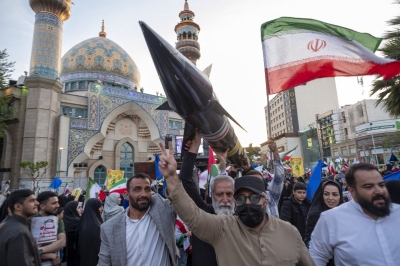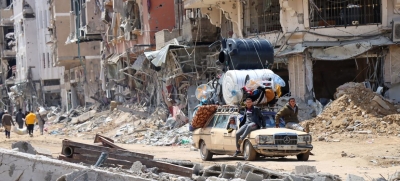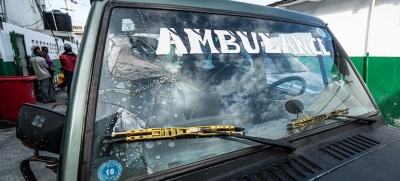NAIROBI, May 03 (IPS) — In a departure from the past, where journalists in Kenya have freely covered anti-government protests unharmed, a series of events that unfolded in March 2023 have heightened fears of the re-emergence of brutal physical attacks on journalists.
According to the Media Council of Kenya, in a span of two weeks, more than 25 journalists were harassed, arrested and held in police cells, physically attacked, expensive equipment destroyed and footage deleted during the opposition-led demonstrations.
Calvin Tyrus Omondi, who participated in the recent March protests and many others before, tells IPS that “journalists usually cover demonstrations while standing on the side of the police officers because they are safe there. This time round, tear gas canisters were being fired at journalists. Tear gas canisters are used by police officers, so many journalists were very frightened because the canister can hit and kill somebody.”
“There were also a few hired goons who did not want the demonstrations to continue and were throwing stones at journalists. The journalists were not safe with the police officers or with the crowds. Some were even robbed.”
One of the most brutal incidences was the attack on Cameraman Eric Isinta, who was hit by three tear gas canisters in quick succession on the face and abdomen; he fell from the press vehicle and was seriously injured.
“Access to reliable official information is of critical importance during times of crisis. Trustworthy news and images may help protect civilians and contribute to diffusing tensions. Journalists are often the source of this information,” Harrison Manga, Country Director of Media Focus on Africa, tells IPS.
“But journalists are also often the target of the parties in a crisis, as seen in the recent attacks on journalists covering the opposition called demonstrations in Nairobi in March 2023. Press freedom demands that journalists’ safety be guaranteed by state and non-state actors alike at all times and especially during times of crisis.”
It was, therefore of great concern when notable and influential figures within the government rank openly and publicly intensified verbal attacks against the media fraternity in remarks that erased all doubt about the vulnerabilities of journalists covering volatile political situations.
Dr Jane Thuo, a lecturer in Journalism and Mass Communication tells IPS that against this backdrop, equipment to protect journalists in such volatile situations, where tear gas cannisters are used as weapons and live bullets are fired, are simply not adequate.
Take for instance injured Cameraman Isinta who was wearing protective head gear but still came close to losing an eye and having his face permanently deformed. A number of journalists suffered head injuries despite wearing helmets as tear gas cannisters were purposely and with precision shot at their heads and face area, or abdomen.
“We need to explore technology to keep our journalists safe. Drone journalism or the use of unmanned aerial vehicles holds great potential for news gathering purposes during a volatile environment such as political protests, violent conflict and natural disaster without placing the lives and health of our journalists at risk,” Thuo expounds.
She says that drones, which are small unmanned aircrafts operated remotely by a person on the ground, can facilitate journalists to remain true to their calling by providing the public with accurate and timely information without becoming collateral damage or even losing expensive equipment.
Footage of volcanic eruptions, war-torn villages, and nuclear disasters have all been made possible by drone technology, and experts such as Thuo are stressing that the time has come for journalists in Africa, particularly those covering active armed conflict, to turn to drone technology.
There are at least 15 armed conflicts in Africa today in countries such as Sudan, the Democratic Republic of Congo, Cameroon and Ethiopia, where at great risk to their lives, journalists continue to expose ongoing atrocious crimes against humanity.
As such, drone photos, videos and live streaming capacities can enable journalists to make, their news reports more insightful and innovative, especially in the coverage of fast-moving and in areas that are too dangerous for journalists.
Thuo speaks of companies, NGOs and universities that are testing drones in this context, including the Drone Journalism Lab at Nebraska-Lincoln College of Journalism and Mass Communication. Closer home, the africanDRONE, a pan-African community of drone operators and journalists, is committed to using drones.
A picture may well be worth a thousand words, but as camerapersons and photographers find themselves on the receiving end and at risk of serious and life-threatening bodily harm, Thuo says media stakeholders must, as a matter of urgency, begin to explore legislation to facilitate drone journalism in times of crisis.
“We have to factor in the issues of protecting people’s privacy, public safety and journalism ethics. It is possible to craft legislation that takes these critical issues into account because they are at the heart of human rights. There is room to weigh the benefits and concerns of gathering news using drones in dangerous situations and establish a progressive legal framework,” Thuo observes.
She confirms that drones can indeed be misused, but with wide-ranging consultations with media stakeholders, human rights experts and technical experts in fields such as the aviation industry, “it is possible to establish parameters that enable journalists to revolutionize news coverage using technology such as drones.”
Drone Laws in Kenya permit drone ownership by citizens over the age of 18 years, residents, businesses and governments. All drones must be registered by the Kenya Civil Aviation Authority.
Thuo says there is a need to analyze Kenya’s drone laws to find out if they restrict or facilitate drone journalism and to what extent and determine steps that relevant stakeholders could take to help improve the safety and security of journalists through innovative technology.
IPS UN Bureau Report






